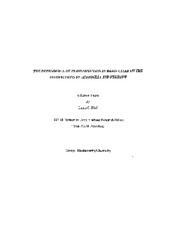| dc.contributor.advisor | Tiffany-Castiglioni, Evelyn | |
| dc.creator | Bird, Laura C. | |
| dc.date.accessioned | 2013-02-22T20:41:15Z | |
| dc.date.available | 2013-02-22T20:41:15Z | |
| dc.date.issued | 1998 | |
| dc.identifier.uri | https://hdl.handle.net/1969.1/ETD-TAMU-1998-Fellows-Thesis-B57 | |
| dc.description | Digitized from print original stored in HDR. Due to the character of the original source materials and the nature of batch digitization, quality control issues may be present in this document. Please report any quality issues you encounter to digital@library.tamu.edu, referencing the URI of the item. | en |
| dc.description | Includes bibliographical references: leaves 24-25. | en |
| dc.description | Program year: 1997/1998 | en |
| dc.description.abstract | Lead (Pb) is a ubiquitous environmental contaminant which has been linked to neurobehavioral deficits, primarily in young children. A current hypothesis for Pb distribution among brain cells is that astroglia, which are interposed between the blood capillaries and neurons, protect neurons by Pb uptake and storage. This property of astroglia is thought to develop with age, and is not present in very young animals. The purpose of this study was to test three hypotheses: that maturation of neuronal cells affects their Pb accumulation, that soluble factors secreted into astroglial environment alters their Pb accumulation, and that astroglia preferentially sequester Pb over neurons. In an initial experiment, SY5Y human neuroblastoma cells were exposed to medium containing low levels of Pb and Neuronal Growth Factor-β (NGF- β), a soluble factor secreted by astroglia which induces cell maturation. In a second experiment, astroglia were exposed to endothelial-, astroglia-, and neuronal-conditioned media containing low levels of Pb. In a final experiment, astroglia and neuronal cells were exposed to Pb in a bicameral co-culture system, in which cell types were physically separated but shared a common pool of medium. Graphite Furnace Atomic Absorption Spectroscopy (AAS) was used to determine Pb amounts, which were expressed per number of cells. Results showed neuronal cell maturation, induced by NGF-β, lead to a decrease in Pb uptake. Furthermore, soluble factors secreted by neuronal cells caused a significant increase in the amount of Pb uptake by cultured astroglia, as determined in both conditioned medium and co-culture experiments. Our findings support the conclusion that astroglial accumulation of Pb increases with exposure to influencing factors from neuronal cells and that neuronal cell accumulation decreases with maturation. These finding are in agreement with the Lead sink hypothesis. | en |
| dc.format.extent | 30 pages | en |
| dc.format.medium | electronic | en |
| dc.format.mimetype | application/pdf | |
| dc.language.iso | en_US | |
| dc.rights | This thesis was part of a retrospective digitization project authorized by the Texas A&M University Libraries in 2008. Copyright remains vested with the author(s). It is the user's responsibility to secure permission from the copyright holder(s) for re-use of the work beyond the provision of Fair Use. | en |
| dc.subject | Lead | en |
| dc.subject | brain cells | en |
| dc.subject | astroglia | en |
| dc.subject | neuronal cell maturation | en |
| dc.subject | Neuronal Growth Factor-β | en |
| dc.subject | astroglial accumulation | en |
| dc.subject | Lead sink hypothesis | en |
| dc.title | The dependence of Pb distribution in brain cells on the interactions of astroglia and neurons | en |
| thesis.degree.department | Veterinary Anatomy and Public Health | en |
| thesis.degree.grantor | University Undergraduate Research Fellow | en |
| thesis.degree.name | Fellows Thesis | en |
| thesis.degree.level | Undergraduate | en |
| dc.type.genre | thesis | en |
| dc.type.material | text | en |
| dc.format.digitalOrigin | reformatted digital | en |


